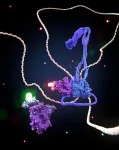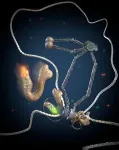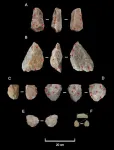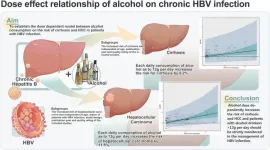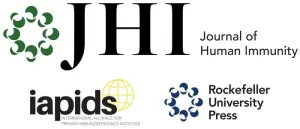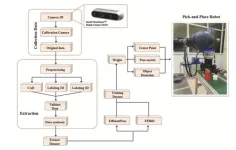(Press-News.org) Scientists from Delft, Vienna, and Lausanne discovered that the protein machines that shape our DNA can switch direction. Until now, researchers believed that these so-called SMC motors that make loops into DNA could move in one direction only. The discovery, which is published in Cell, is key to understanding how these motors shape our genome and regulate our genes.
Connecting DNA
“Sometimes, a cell needs to be quick in changing which genes should be expressed and which ones should be turned off, for example in response to food, alcohol or heat. To turn genes off and on, cells use Structural Maintenance of Chromosomes (SMC) motors that act like switches to connect different parts of DNA”, first author Roman Barth explains. “However, SMC machines don’t naturally know which parts to connect. They simply load somewhere on the DNA and start shaping it into a loop until they reach a point where they are forced to stop. That’s why they rely heavily on the ability to explore both sides of the DNA to find the right stop signs.”
Gearbox
Biophysicists at Delft University of Technology now found that SMC motors can switch direction, contrary to what was thought to be possible. “Our experiments show that SMCs momentarily pull DNA from one side, and then switch direction to pull DNA from the opposite side. By doing so, they can pull DNA into a loop from both sides over time. We found this to be true for all types of SMC motors, of which there are many”, Delft professor Cees Dekker, who supervised the research, says. “You can compare it to a gearbox in a car: With a manual gear stick you can let the car move forward or backward. We even identified the ‘gear lever’, protein subunit NIPBL, in the cohesin SMC motor protein.”
Impressive nanotechnology
To discover the reverse gear of SMC motors, the researchers used an advanced home-built microscope to look at single proteins on individual DNA molecules. That in itself is an impressive achievement, as Barth explains: ”A single cell contains millions of proteins and the human body is made of trillions of cells. Pulling out a few proteins and being able to ‘watch’ them one by one is a remarkable feat of nanotechnology that involves imaging at a scale of nanometres – 100,000 smaller than the width of a human hair.”
Neurodegenerative diseases
“Once we understand how SMC molecular motors shape DNA, we may start asking what goes wrong in diseases like cancer and neurogenerative diseases, and importantly, how to correct it”, says Barth. “Neurogenerative diseases for example can be the result of misregulated genes during early stages of pregnancy. In fact, there are a couple of severe diseases, such as Cornelia de Lange syndrome, linked to SMCs, where the motors likely fail to switch correctly inside the cells of the embryo.”
Science in action
The study finally resolves the confusion in the scientific community about various contradictory theories on how SMCs work. Early research suggested that SMCs can strictly move in one direction only, while other research suggested that they pulled in DNA from both sides simultaneously. The discovery resolves these controversies. Barth: “Having found commonalities among SMC motors helps to focus and streamline the SMC research field. We don’t have to look for a new mechanism for every individual type of SMC protein anymore. It will also accelerate the field towards applied science. I would be glad to see this knowledge move into pharma companies, hospitals, and eventually doctors’ offices.”
END
DNA motors found to switch gears
2025-01-16
ELSE PRESS RELEASES FROM THIS DATE:
Human ancestor thrived longer in harsher conditions than previous estimates
2025-01-16
An early human ancestor of our species successfully navigated harsher and more arid terrains for longer in Eastern Africa than previously thought, according to a new study published in Nature Communications Earth & Environment.
Homo erectus, the first of our relatives to have human-like proportions and the first known early human to migrate out of Africa, was the focus of the new study led by the international research team.
The researchers analysed evidence from Engaji Nanyori in Tanzania’s Oldupai Gorge, revealing Homo erectus thrived ...
Evolution: Early humans adapted to extreme desert conditions over one million years ago
2025-01-16
Homo erectus was able to adapt to and survive in desert-like environments at least 1.2 million years ago, according to a paper published in Communications Earth & Environment. The findings suggest that behavioural adaptations included returning repeatedly over thousands of years to specific rivers and ponds for fresh water, and the development of specialised tools. The authors propose that this capability to adapt may have led to the expansion of H. erectus’ geographic range.
There has been significant debate over ...
Race and ethnicity and diffusion of telemedicine in Medicaid for schizophrenia care after onset of the COVID-19 pandemic
2025-01-16
About The Study: In this cohort study of Medicaid beneficiaries with schizophrenia, telemental health care diffused rapidly after the onset of the COVID-19 pandemic, particularly in state-operated agencies. Together, agency-level and beneficiary-level race and ethnicity findings suggest within-agency racial and ethnic differences in diffusion of telemental health care. States should monitor the diffusion of innovations across vulnerable populations.
Corresponding Author: To contact the corresponding author, Sharon-Lise Normand, PhD, email sharon@hcp.med.harvard.edu.
Embed this link to provide your readers free access to the full-text article This ...
Changes in support for advance provision and over-the-counter access to medication abortion
2025-01-16
About The Study: In this serial cross-sectional analysis of people ages 15 to 49 before Dobbs and 1 year after Dobbs, findings suggested that national support for expanded access to medication abortion has grown. Alternative models of care, such as advance provision and over-the-counter, have the potential to offer a promising approach to abortion care, particularly for people living in abortion-restricted states.
Corresponding Author: To contact the corresponding author, M. Antonia Biggs, PhD, email antonia.biggs@ucsf.edu.
To access the embargoed study: Visit ...
Protein level predicts immunotherapy response in bowel cancer
2025-01-16
Francis Crick Institute press release
Under strict embargo: 16:00hrs GMT Thursday 16 January 2025
Peer reviewed
Observational study
People and cells
Protein level predicts immunotherapy response in bowel cancer
Researchers at the Francis Crick Institute and Barts Cancer Institute, Queen Mary University of London, have shown that the amount of a protein called CD74 can indicate which people with bowel cancer may respond best to immunotherapy.
If integrated into the clinic, testing for this protein could potentially allow hundreds of previously ineligible patients to benefit ...
The staying power of bifocal contact lens benefits in young kids
2025-01-16
COLUMBUS, Ohio – Young nearsighted kids who wear bifocal contact lenses that slow uncoordinated eye growth do not lose the benefits of the treatment once they stop wearing the lenses, new research shows.
The study is a follow-up to a clinical trial published in 2020 showing that soft multifocal contact lenses with a heavy dose of added reading power dramatically slowed further progression of myopia in kids as young as 7 years old. Researchers wondered if discontinuing that treatment might cause a rebound of faster-than-normal eye growth that wipes out the benefit.
In the new trial, nearsighted kids wore ...
Dose-dependent relationship between alcohol consumption and the risks of hepatitis b virus-associated cirrhosis and hepatocellular carcinoma: A meta-analysis and systematic review
2025-01-16
Background and Aims
The quantitative effects of alcohol consumption on cirrhosis and hepatocellular carcinoma (HCC) in hepatitis B virus (HBV) infection are unknown. This study aimed to establish a dose-dependent model of alcohol consumption on the risks of cirrhosis and HCC.
Methods
PubMed, Embase, the Cochrane Library, Web of Science, and four Chinese databases were searched for studies published from their inception to 15 May 2024. A random-effects model was used to pool the data on the incidence of cirrhosis and HCC, and a dose-dependent model of alcohol’s effect on cirrhosis and HCC was established.
Results
A total of 33,272 HBV patients ...
International Alliance for Primary Immunodeficiency Societies selects Rockefeller University Press to publish new Journal of Human Immunity
2025-01-16
January 16, 2025 – New York, NY – The International Alliance for Primary Immunodeficiency Societies (IAPIDS) and Rockefeller University Press (RUP) have entered a partnership to launch Journal of Human Immunity (JHI), the official open access journal of IAPIDS. This collaboration will ensure that JHI emerges as the destination for exciting research into human immunity, with a particular focus on inborn errors of immunity.
“The Journal of Human Immunity represents a bold step forward in advancing ...
Leader in mission-driven open publishing wins APE Award for Innovation in Scholarly Communication
2025-01-16
Digital Science is pleased to announce that Dr Raym Crow, a leading figure in mission-driven, sustainable open publishing models, has won the 2025 APE Award for Innovation in Scholarly Communication.
The award – a joint initiative between Digital Science and the Berlin Institute for Scholarly Publishing (BISP) – has been announced at the 20th Academic Publishing in Europe (APE) Conference in Berlin, Germany.
The APE award is presented to an individual who has brought innovation in scholarly communication to the community, through infrastructure, technology, business models, output on the topic, theory, or practice.
With more than ...
Innovative 6D pose dataset sets new standard for robotic grasping performance
2025-01-16
Accurate object pose estimation refers to the ability of a robot to determine both the position and orientation of an object. It is essential for robotics, especially in pick-and-place tasks, which are crucial in industries such as manufacturing and logistics. As robots are increasingly tasked with complex operations, their ability to precisely determine the six degrees of freedom (6D pose) of objects, position, and orientation, becomes critical. This ability ensures that robots can interact with objects in a reliable and safe manner. However, despite advancements in deep learning, the performance of 6D pose estimation algorithms largely depends ...
